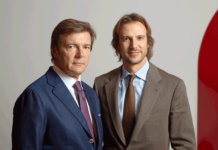By Patrick ONeill and Bill Malloy III, MWM, a multi-family office
The Purpose of Wealth
The purpose of wealth is not to serve itself, but to serve the family and society. American industrialist Henry Ford famously said, “The highest use of capital is not to make more money, but to make money do more for the betterment of life.” When viewed in this way, financial capital is not an end, but simply a means to an end. It is the tool that can allow your family to achieve their goals, never the goal itself.
Understanding your family’s wealth, its human, intellectual and financial capital, will allow you to understand how to utilise those assets in order to provide the freedom and resources for each member to “do more for the betterment of life.” Wealth, when applied correctly, can better you, your fellow family members, your community and, depending on how that wealth is managed and utilised, it can create a better world globally, while still providing for your family in perpetuity. Each member of the family should be educated on the spiritual and moral values of the family, particularly as they relate to the family’s mission, system of governance, and philanthropic efforts. It should be stressed upon each member the effect that hard work has upon self-worth, and that all work is equal to the family regardless of its financial reward.
[ms-protect-content id=”4069, 4129″]
Philanthropy and Family Wealth Preservation
Firstly, it is important to understand that family wealth is a journey, and ideally, a journey with no end. There is no final destination or finish line, rather an endless circle of mass migration. This is merely the nature of time and wealth, and cannot be ignored or impeded. It is an ongoing journey that will provide for future generations, but must be maintained by the family. The founders of a family office are not holding the entire family on their shoulders, but instead simply taking the first of many steps. Some of them will be over smooth paths, some rocky inclines; but none of them should be taken alone. The goal of this process is to preserve the family’s wealth, its human, intellectual and financial capital, through the generations for the betterment of the members and the whole.
Jonas Salk, the creator of the polio vaccine, who eventually gave his gift to the world, once said notably, “Our greatest responsibility is to be good ancestors.” While it is easy to understand how one might be a good descendent, being a good ancestor is something that we, as humans, rarely consider. The goal of this mindset is to teach us to shift our thinking from ourselves and our own heritage, to the heritage we would like to leave to the generations that follow, and the generations we will never meet.
Maintaining Family Unity
The goal of a family office is not to exist to serve itself, but to serve the members of the family and allow them the freedom to pursue happiness while still remaining a close, productive member of the family. Inevitably, some members of the family may not have any interest in pursuing the family business or finances, rather, they may excel in other areas, or feel called to different industries or causes.
We have seen in our history, the ability for divisions to be created within the family by individuals seeking other paths, and we have learned both first-hand and through studying other great families, that this is natural. Yet, these inevitabilities do not have to leave a negative impact on the family structure. Philanthropy, when introduced to the family members as a core family component, can have the power to unify. Discovering that a previously excluded member of the family has a particular talent or passion can embolden a family, and should be viewed as an increase in human capital and therefore an increase in the family’s overall wealth.
There are many different structures that can not only strengthen wealthy families, but also provide the family members with a unified set of values or an individual purpose that would be difficult to otherwise find. One such structure, which can be essential in providing the members of a family with this sense of purpose, is a philanthropic committee. When families possess a structure to deal with philanthropy, they can give each member an aspect of the family to be proud of and to be a part of. Philanthropy can provide responsibility and inclusion to family members that may feel alienated by the rest of the family, or feel they lack a role within the family. Not every family member will have a head for leadership, investment or other financial tasks, and these members often find their true purpose in the charitable accomplishments of the family.
A Tool to Engage and Educate the Younger Generation
Another way that philanthropic efforts can unify the family is through the inclusion of younger generations, teaching them the history of the family, promoting stewardship of assets, monitoring of results, and training them for other more prominent roles within the family. Property utilised philanthropic efforts can serve as an educational tool for families, identifying strengths, and cultivating the future leaders of the family.
Within families, education of each generation should be looked at as a graph, one in which the vertical axis represents the amount of education and the horizontal axis represents time. For many parents and older generations, this graph will appear stay fairly low until the mid-twenties to thirties and then increase sharply. It is not difficult to see the reality in this. There is often simply too much information, too many complexities to wealth management for the next generation to learn quickly. However tools like philanthropy offer a different approach. The children of wealthy families can be taught the values and financial responsibilities of the family gradually, so that the graph curves upwards. In this way, education builds off of education, information off of information, allowing the learning to take place naturally and over time.
History and Sense of Family
Philanthropy teaches younger generations lessons about wealth, values, and the importance of giving back. A properly structured program might begin with a history of the family itself, its origins and the struggles it has endured to get to where it is today. This sense of family is vitally important for each generation to hold and pass down to future generations, and philanthropy provides a mechanism for this. Additionally, it provides a forum for younger family members to understand the spiritual and moral values of the family, particularly as they relate to the family’s mission, system of governance, and philanthropic efforts.
Stewardship
The ideal member of a family is an “active stakeholder”, as opposed to a “passive shareholder.” The difference between stakeholders and shareholders essentially comes down to the amount of effect that the member has upon the family, and the amount that the family can affect the member. Active stakeholders are members that not only maintain but add to the family’s human, intellectual, and financial capital. Engaging younger members of the family in philanthropic activities teaches them the lessons needed to become good stewards of the family wealth, in an environment where they can learn, and the pressure for financial returns is not as great as it may be in other areas of family stewardship.
Measuring Results
All too often, families never stop to quantify the methods by which they operate, instead choosing to rely on reactionary thinking and gut instinct to lead the way. But while this sort of impulsive management may pan out occasionally, depending on the luck of the decision maker, it never leads to truly intelligent decisions. However, when families and governing bodies understand how their actions influence their outcomes, intelligent decisions can result in efficiency above and beyond what would otherwise be possible. Philanthropy provides the perfect backdrop for younger family members to grow accustomed to planning, measuring, and adjusting. As with stewardship, it creates an environment where they can learn and grow, without a tremendous amount of pressure to succeed. It teaches that without understanding the effectiveness of your actions it’s impossible to know if they are the correct actions, a lesson essential in engraining in younger minds.
Conclusion
Families that have a set of core beliefs, a shared sense of purpose and an understanding that together the group is greater than any one individual member have already crossed one of the main obstacles in their journey for longevity. Philanthropy supports this journey and serves a tool for families to unify the individual members around value, purpose, and the betterment of society. It recognises and acknowledges the differences within a family and provides a forum where members can pursue their creativity and passions. Lastly, philanthropy can support the cultivation of younger generations by educating them around the family history, teaching them to be good stewards, and training them is areas of management, measurement and results, all within an environment that is conducive to learning. Philanthropy provides a family and its members the opportunity to give back to mankind in each of the three areas of human, intellectual and financial capital, by way of time, talent, and capital.
Tharawat Magazine, Issue 25, 2015
[/ms-protect-content]













